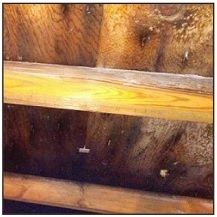 Your home’s attic plays a very important role in ensuring your roof system lasts a long time. As outlined in our article on the benefits of a Properly Ventilated and Insulated Attic, having a properly ventilated attic is key to an energy efficient attic. One consequence of not having a well functioning and improperly ventilated attic is the growth of attic mold.
Your home’s attic plays a very important role in ensuring your roof system lasts a long time. As outlined in our article on the benefits of a Properly Ventilated and Insulated Attic, having a properly ventilated attic is key to an energy efficient attic. One consequence of not having a well functioning and improperly ventilated attic is the growth of attic mold.
Mold is usually due to dampness and humidity in closed spaces. It could form is all areas of your home, with the attic being one of the areas where mold thrives. Given the kind of winters we normally get in Chicagoland area, attic mold typically grows during the colder months when the hot air from home heating rises up to the attic. In a properly ventilated home, this is not an issue as hot air is able to escape the attic through outtake air vents.
Inadequate Attic Ventilation Leads to Mold Growth in Attics
The top reason for mold growth in attics is because of inadequate attic ventilation. Thi必利勁
s can be caused by blocked roof or soffit vents or having an insufficient number of vents installed. Your home could also have kitchen and bathroom exhaust fans that goes up to your attic instead of outside. Other reasons for mold growth is poor or insufficient attic insulation, or you may have a leaky roof.
It is important to inspect your attic regularly. Because homeowners don’t usually go up and check their attics, mold growth may go undetected for years. Mold formation usually occurs on the roof decking and ceiling rafters. If you see in the attic black stuff on your roof sheathing and roof joists, that is probably mold. Too much moisture and humidity in an improperly ventilated attic are the prime reasons for black mold in attics. Kitchen and bathroom exhaust fans and clothes dryer should not be vented into the attic, outside of the house only.
If you notice mold growth in your attic, it is important to get this treated early because leaving it untreated could impact the longevity of your roof shingles and even create structural problems to your home.
